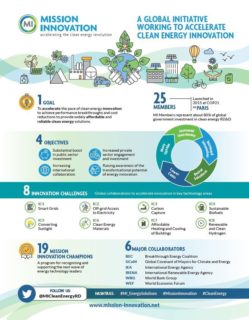-
Mission Innovation approaches five-year milestone… Where next?
Date posted:
-
-
-
Post Author
Philip SharmanIFRF Director
-

Two weeks ago, the Mission Innovation (MI) Secretariat published ‘Mission Innovation Beyond 2020: Challenges and opportunities’, summarising the current status and future trends in clean energy innovation to help inform discussions about the future of Mission Innovation.
IFRF has reported on various outputs of MI over the last three years in our Monday Night Mail (most recently a blogpost on 25th November highlighted recommendations made in a summary report following a workshop on CCUS held in Norway earlier in the year), but some of you may not be familiar with this important international initiative aimed at accelerating clean energy innovation.
MI was launched by twenty Heads of State at COP21 to respond, with government commitments, to the urgent need to accelerate innovation and make clean energy widely affordable. Over the past four years, through activities at the national and international level, members have increased funding, set-up new collaborations, celebrated leading innovators and developed new frameworks to identify the most impactful clean energy solutions. At the 4th MI Ministerial, ‘The Story So Far: An impact review’ showcased progress against these goals.
As MI comes towards the end of its first five year mandate, members are discussing the potential scope and priorities for a second phase of MI by reflecting on its purpose, identifying today’s challenges, and developing a compelling vision and narrative that can spur business and political leadership around the world.
To inform these discussions, the MI Secretariat has examined key developments and trends in clean energy innovation by interviewing experts around the world, by conducting its own analysis and by summarising the literature to produce the recent summary paper.
The four key messages that emerge from the paper are:
- Given that new innovations have long incubation times, the literature indicates that timelines can be shortened by a system-wide approach to innovation that includes developing a clear and long-term vision, increasing skills, strengthening networks, investing in demonstrations, nurturing markets and building user acceptance.
- Public and private investments in clean energy innovation are increasing slowly. However, they are still a small share of total R&D budgets and public investment in energy innovation is half the level as a share of GDP that it was in the late-1970s.
- Trends of rising energy access, electrification, digitalisation and net-zero targets in some countries are shifting innovation priorities, with major challenges including providing grid flexibility, integrating and adapting technologies, reducing energy demand and demonstrating and scaling solutions for harder-to-abate sectors.
- Co-ordinated experimentation between countries and innovators can reduce costs and risks, increase confidence amongst innovators and investors and build larger market niches, but priorities need to be aligned, trust established, and mechanisms need to be efficient to achieve impact.
So what priorities does the MI report identify for innovation in clean energy in the next decade?
- Early-stage R&D:
- Collaborative R&D programmes bringing together the best researchers and innovators to deliver radical innovations that will be essential for clean energy beyond 2030:
- advanced energy materials with improved performance for batteries, solar conversion and buildings
- converting sunlight to liquid fuels and hydrogen
- carbon dioxide removal (CDR) technologies
- Collaborative R&D programmes bringing together the best researchers and innovators to deliver radical innovations that will be essential for clean energy beyond 2030:
- Cost reductions and demonstrations:
- Collaborative demonstrations of capital-intensive technologies and/or procurement agreements to rapidly reduce costs and nurture niches for solutions likely to underpin clean energy transition in industry and heavy transport , and to enable high penetration of renewables:
- hydrogen
- advanced biofuels
- energy storage
- carbon capture, utilisation and storage (CCUS)
- Collaborative demonstrations of capital-intensive technologies and/or procurement agreements to rapidly reduce costs and nurture niches for solutions likely to underpin clean energy transition in industry and heavy transport , and to enable high penetration of renewables:
- Systemic innovation:
- Innovation in the integration and operation of the energy system such as:
- better data to manage multi-vector energy systems
- building optimisation
- behavioural science on the use of energy and demand shifting
- Innovation in services to reduce demand (e.g. energy as a service)
- Innovative finance models that enable emerging technologies to access funding such as peer-to-peer lending.
- Innovation in the integration and operation of the energy system such as:
Quite a lot there of interest to IFRF members…! We will continue to keep you updated on relevant outputs from MI.
